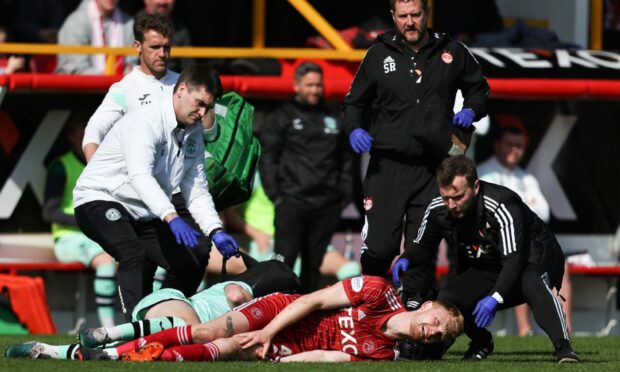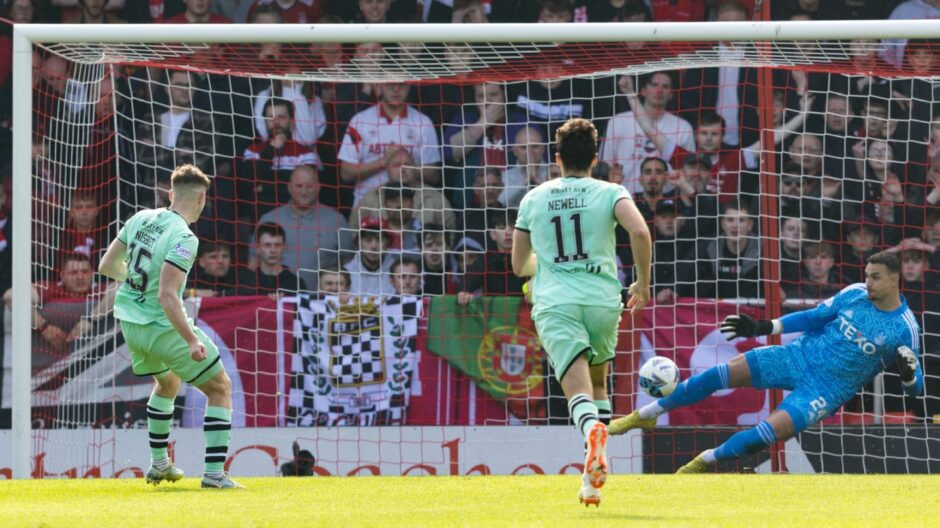Aberdeen battled to a 0-0 draw with Hibs on Saturday – on the weekend the Gothenburg Greats returned to Pittodrie. But how did the officials perform?
Following the Premiership clash, the general consensus has been the Dons were perhaps fortunate to get a point, having not hit anything like the heights they have in previous games during Barry Robson’s short tenure and with Kelle Roos saving a Hibees spot-kick, taken by Kevin Nisbet, in the second period.
All games come with debate over refereeing decisions, and the Reds v Hibs meeting was no different.
Below, our refereeing expert Finlay Elder reviews the performance of whistler Nick Walsh and his team at stadium, as well as VAR:
Walsh hesitated on Campbell high boot call – and refs should be able to take a no-pressure second look via monitor in those moments
We start with a big shout of a red card for Hibs midfielder Josh Campbell.
As the ball headed towards Aberdeen loan defender Liam Scales, the two players collided. It was a nasty clash.
My first instinct was a red card for Campbell – I thought his foot was high and was certainly endangering his opponent.
Campbell challenge on Scales. Yellow or red card? #aberdeenfc #HibernianFC #SPFL pic.twitter.com/CYWFbr1j9f
— Mark Stewart (@CompuScot) May 13, 2023
I have certainly seen challenges like that punished with a red, and it did initially appear actually referee Walsh was going to rush over and dismiss the visiting player.
However, Walsh then gave himself some time to make his mind up about the decision, eventually deciding a yellow was enough. A VAR check then backed the referee’s decision.
I personally felt the beat Walsh took to come to a decision – which you could call indecisiveness – warranted him heading to the monitor for a second look at the incident.
I feel like there is a pressure on VAR to only send the referee to the monitor if they want the decision to be changed, and I would love to see referees just being sent to the monitor to confirm their decisions – after all, it should be the referee who controls the game.
I think the only thing you could say in defence of the high foot is Campbell is looking at the ball, and he certainly doesn’t intend to hit Scales.
However, again, I do think the challenge could easily be deemed “serious foul play”.
Coulson pen call was correct according to rules – but rules need looked at
The referee would eventually be sent to the VAR monitor at Pittodrie.
Following a shot from Hibs substitute Harry McKirdy, a penalty was awarded after a check for handball.
Absolutely nobody claimed for a handball and, to be perfectly honest, inside the ground, I had no idea what they were even checking for.
Having seen the replays, I think Hayden Coulson can consider himself unlucky, but with the laws of the game as they are, it is a penalty. His arm is classed as being in an unnatural position, and with VAR, they’re always going to award penalties for handball, given the multitude of slowed-down angles.
I think the handball rule needs a complete overhaul, though.
The “unnatural” positions approach is a mess, which can make it very difficult for players to avoid giving away penalties.
It is impossible in some instances of football to keep your hands by your side.
Over the piece on Saturday, I thought ref Walsh had a few more strange decisions, the main gripe for me being the stopping of play for a head knock on Luis “Duk” Lopes.
The Cape Verde international was down clutching his head, as Aberdeen looked to counter from a Hibs attack.
I don’t think the decision to stop play was wrong – I think the time the referee took to give the decision is where the frustration comes from the Red Army. If there’s a head-knock, you stop play as soon as possible… not when the attack of the opposing team is finished.
I did, however, think the referee was spot on with the other yellow cards in the game, and was consistent in his cautions.
- Finlay Elder has been a registered referee for six years and a category 5 official since 2019, with experience in the Highland League, juniors and Club Academy.


Conversation